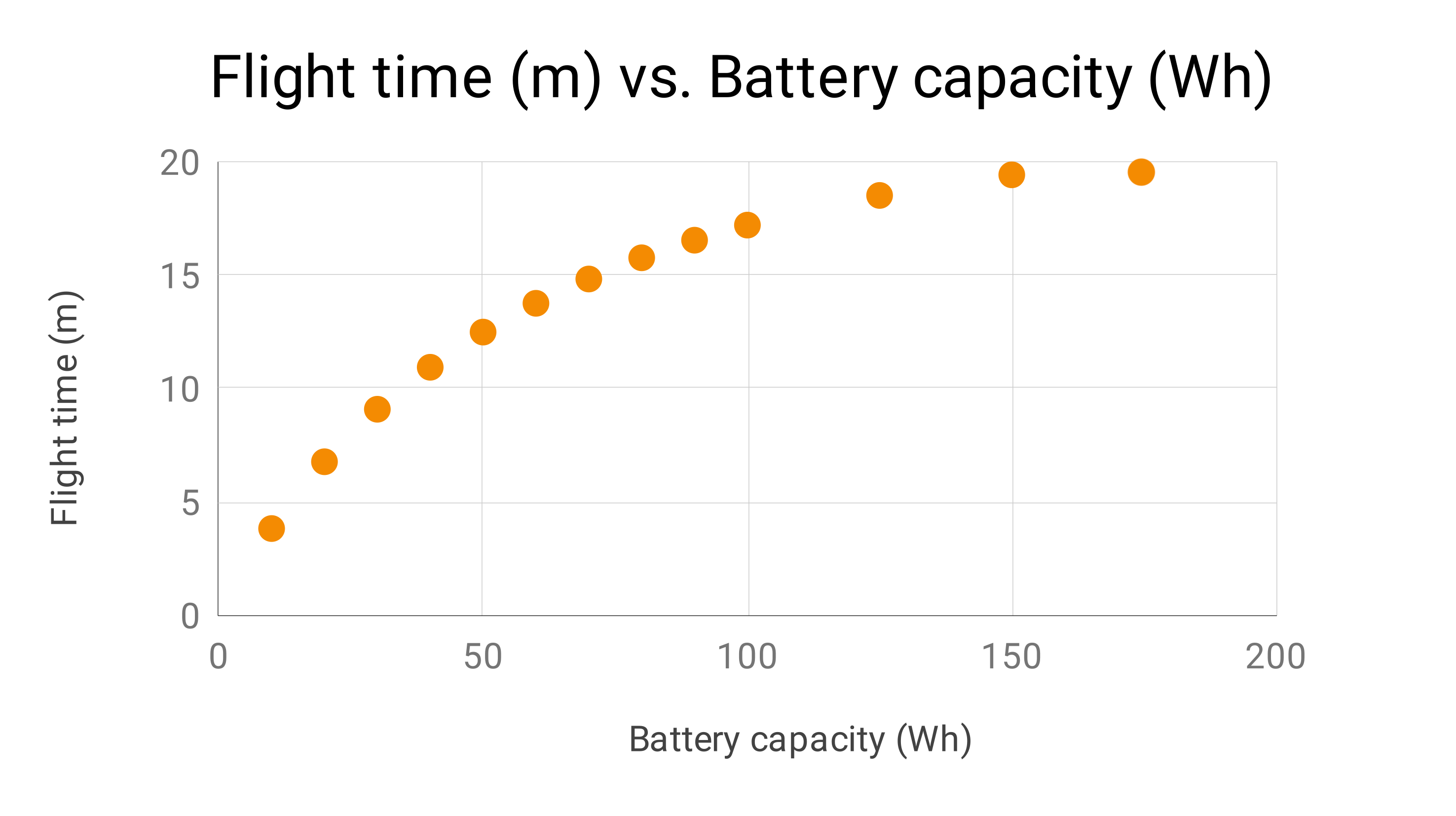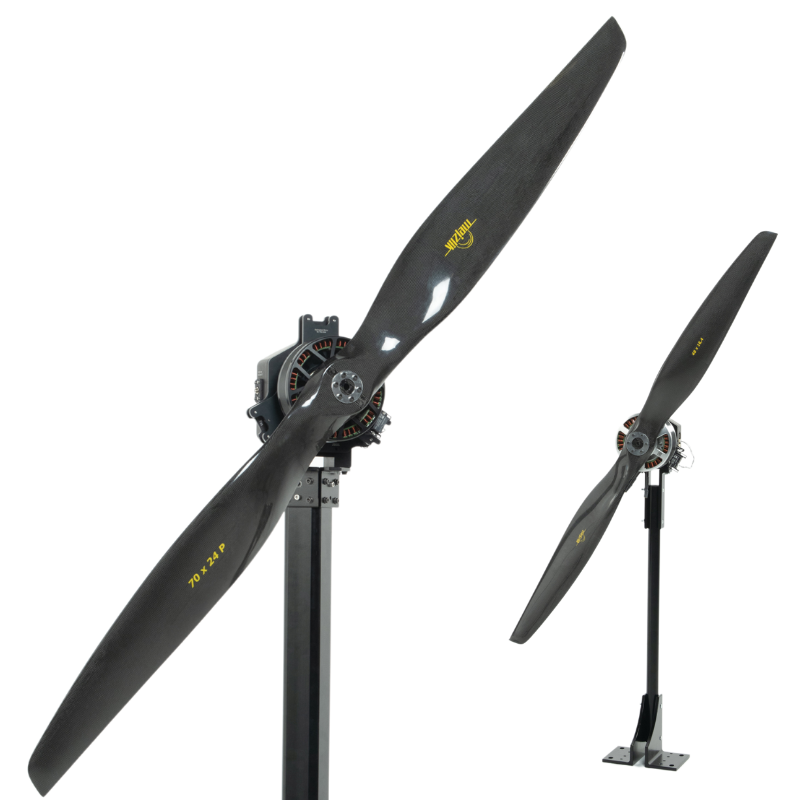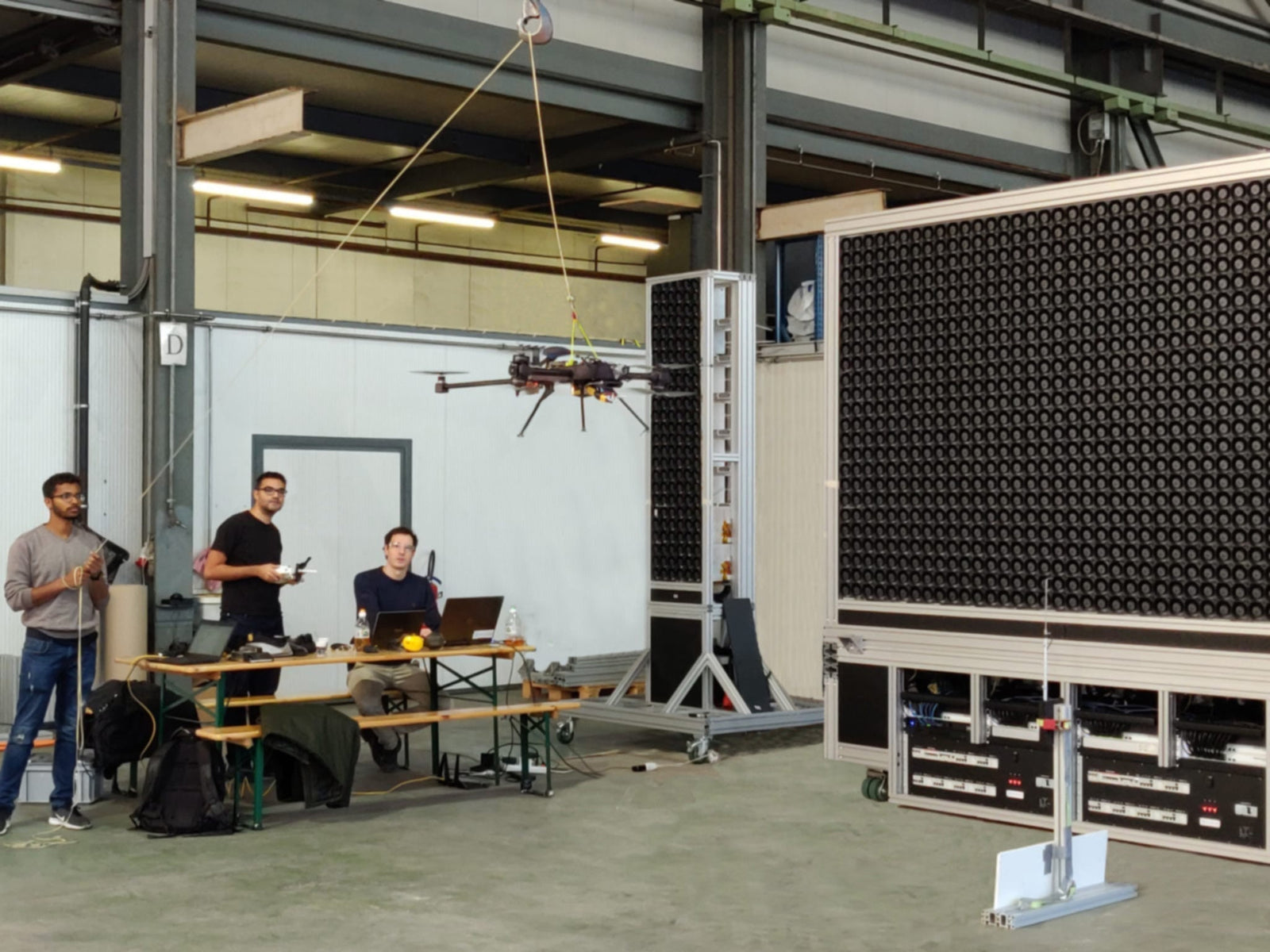By Lauren Nagel
There are hundreds of drone batteries on the market and it can be difficult to decide which one is right for your build. One of the main challenges is decoding the many performance indicators listed on the battery, such as capacity, discharge rating, and cell configuration.
Choosing the right battery for your drone will not only help improve performance, but also increase it’s lifetime. Just like your motor and propeller, your battery will eventually fail, but this can be postponed by choosing the correct one and operating it safely.
In this article we will cover:
- What are LiPo batteries
- LiPo battery safety
- How to read a LiPo battery
- LiPo battery capacity
- Battery voltage rating
- LiPo cell configuration
- Discharge / C Rating
- How to choose a LiPo battery for your drone
- Example - Choosing the right battery for maximum flight time

Figure 1: LiPo battery pack used in Otus quadcopter drone
What are LiPo Batteries
The most common batteries used in drones are lithium polymer (LiPo) batteries. LiPo batteries are composed of a lithium-based cathode and anode separated by a polymer electrolyte.
LiPo batteries differ from other lithium-ion (Li-ion) batteries in that they have a solid polymer electrolyte component rather than a liquid electrolyte. Common polymer electrolytes may be dry, porous or a gel, and include poly(methyl methacrylate) (PMMA), poly(acrylonitrile) (PAN), poly(vinylidene fluoride) (PVdF), and poly(ethylene oxide) (PEO).
The science behind LiPo batteries is the same as in other Li-ion batteries: chemical energy is converted to electrical energy when electrons travel from the battery’s anode to its cathode, creating an electrical current. The cathode contains a lithium metal oxide (such as lithium-cobalt oxide (LiCoO2)), which provides lithium ions, whereas the anode contains a lithium carbon (such as graphite).
The anode and cathode are separated by an electrolyte that interacts with the anode to generate electrons, which creates a charge gradient in the cell. As the anode becomes negatively charged, the electrons travel along a conducting wire to the cathode. The whole system thus undergoes an electrochemical redox reaction (reduction/oxidation): the anode loses electrons and becomes oxidized while the cathode gains electrons and is reduced.

Figure 2: LiPo battery redox reaction
Lithium-based batteries have a higher energy density compared to nickel cadmium or nickel metal hydride batteries, which means they can provide more energy for less weight. LiPo batteries rival Li-Ion batteries in terms of energy density, but are especially popular because they are less likely to leak.
The energy density of LiPo batteries ranges from 140 - 200+ Wh/kg in terms of weight and 250 - 350+ Wh/L for volume. Volume energy density is important to consider when building a drone so the battery fits on the frame, but for performance calculations, the energy density by weight is more relevant. With higher density comes higher cost, so your budget may also be a limiting factor.

Figure 3: Relative energy densities by volume and weight of common battery types (Image: Open Impulse)
A technology that may soon rival LiPo batteries as the drone go-to are Sion Power’s Licerion batteries. These batteries boast an energy density up to 500 Wh/kg and 1000 Wh/L. They also have a 50% lower liquid electrolyte volume compared to other Li-Ion batteries. They were designed specifically for unmanned applications, notably high-altitude pseudo satellites (HAPS) and high-altitude long-endurance (HALE) drones.
Further reading: Types of Drones and UAVs
LiPo Battery Safety
LiPo batteries have a greater risk of fire and swelling than older technologies due to their internal chemistry. Operating the battery at or beyond its limits can lead to the accumulation of oxygen atoms and build up of Lithium Oxide (Li2O), which creates greater internal resistance. More internal resistance leads to more heat, and the thermal runaway cycle begins.
Once the battery pack starts to swell, this is a good indication that the battery is damaged beyond repair or has reached the end of its life cycle. Using it beyond this point will further increase its temperature and potentially lead to a fire.
For common LiPo batteries, the nominal or average voltage is 3.7 V/cell with a maximum voltage of 4.2 V/cell. After the cell is fully charged, it will briefly provide 4.2 V before dropping to 3.7 V for most of the battery life. It becomes dangerous to discharge the battery after the cell voltage has dropped below 3.2 V because the resistance in the battery increases, causing it to heat up and swell, resulting in damage.

Figure 4: LiPo battery on fire (Credit: alishanmao)
To avoid this, many motor manufacturers have added a low voltage cutoff (LVC) to their controls, which stops them from drawing charge after a certain threshold, usually in the range of 3.2 - 3.4 V. Overcharging a LiPo battery is equally dangerous and can result in overheating and evenan explosion.
Lithium ion battery fires are classified as Class B flammable liquid fires, so a type ABC or BC fire extinguisher should be used to put them out. These extinguishers stop the chemical reaction from occurring and eventually put out the fire.
For more LiPo battery safety tips, check out The Drone Girl’s article on “15 things every LiPo battery user should know”.
How to Read a LiPo Battery
LiPo batteries are labeled with a few important pieces of information, including: battery capacity, voltage, cell configuration and discharge rate (figure 15): 
Figure 5: Common LiPo battery labels
LiPo Battery Capacity
Battery capacity is given in mAh or Ah and can be used to estimate your flight time (more on this later). Battery capacity is more specifically defined as the number of hours of current or power the battery can provide. Common units are the ampere-hour (Ah) and the watt-hour (Wh). If a battery has a capacity of 1 Ah, you can draw 1 A of current for one hour. If the capacity is 1 Wh, the battery would provide 1 W of power for one hour.
Battery Voltage Rating
The voltage rating of the battery will allow you to determine your motor speed and amperage. Since motors are rated in Kv with the unit RPM/Volt, the number of volts your battery can supply will determine how fast your motor will spin.
Further reading: How to Calculate Brushless Motor Kv
You can cause damage to your circuit or even cause a fire if your voltage rating is too low or your current drawn is too high, so it is important to choose your battery voltage carefully. To determine the maximum current that your drone will draw, set up your motor and propeller with a propulsion test stand and run them at maximum throttle. The current recorded at 100% throttle tells you the maximum amperage your motor will draw, so multiply this by the number of motors to get the total current draw for your drone. The battery should be able to provide at least this amount of current to avoid overheating.
Another way to determine the maximum amperage you can draw from the battery is by multiplying the capacity in Ah by the C rating. For a battery rated for 5800 mAh/5.8 Ah and 25C continuous, the maximum current you can safely draw is 145 A (5.8 x 25 = 145).
LiPo Cell Configuration
The cell configuration is sometimes present on the label and describes the number and layout of LiPo cells in the battery. Recall that one LiPo cell has a nominal voltage of 3.7 V and several LiPo cells can be connected in series. A 4S battery would have four LiPo cells in series (S), giving a 14.8 V battery (4 x 3.7 V = 14.8 V). A battery might also have a code like 4S2P, which tells us that there are four cells connected in series and two cell sets connected in parallel (P), for a total of eight LiPo cells.
Discharge/ C Rating
The discharge rate or the C rating is a measure of how quickly the battery can safely discharge. If a battery has a C rating of 25 and a capacity of 5800 mAh/ 5.8 Ah, you could safely discharge it at 25 times the capacity of the battery, 25 x 5.8 = 145 Ah. With continuous power at that rate, the 5.8 Ah battery could be discharged in 2.4 minutes ((5.8 / 145) x 60 = 2.4). Batteries may also have a range or ‘peak’ discharge rate, where the battery may exceed its constant power output for a short period of time without overheating, such as during a sudden climb or correction. A higher C rating is great for applications like drone racing that require bursts of speed, since the battery can deliver the charge needed very quickly.
How to Choose a LiPo Battery for Your Drone
The best battery for your drone is the one that best suits your application. If flight time is your main concern, you will want to reduce your mass and maximize battery capacity (equation 1), which is dependent on energy density and mass (equation 2).


Where:
E = capacity
σ = energy density
M = mass in grams (g)
If power and speed are your top priorities, you will want a battery that can deliver high amounts of charge quickly and without overheating, so you're looking for a high voltage and C rating.
Here is a summary of how each battery variable affects your performance:
Battery capacity
- Higher capacity → longer flight time → higher mass
- Increasing battery capacity will give you more flight time, but with diminishing returns as the mass of the battery increases (figure 6)
- Testing several batteries can help you find the maximum useful capacity
Further reading: How to Increase Your Drone's Flight Time and Lift Capacity

Figure 6: Drone flight time vs. Battery capacity
Voltage
- Higher voltage batteries will spin the motor at a higher RPM, so find a voltage that matches your desired rotation speed range
- Higher voltage batteries tend to be more efficient but also heavier - consult efficiency values from thrust tests to find a balance
Discharge/ C rating
- Choose a rating based on your application - high speeds and quick delivery vs. constant low power
- If the discharge rate is too low, your drone will lack power and underperform
- If the discharge rate is too high, you may be carrying unnecessary weight
Current draw
- Use the techniques mentioned to determine the current drawn by your motors
- The battery should be able to provide at least as much current as the drone will draw to avoid overheating
Example - Choosing the Right Battery for Maximum Flight Time
In order to demonstrate the process of choosing the right battery, we will use the example of building a drone for agriculture - it must have a long flight time, but we don’t need fast power bursts. We will use data we’ve collected on our propulsion system to inform our decisions.
We want to choose a battery with the highest possible capacity that keeps our drone’s total mass at a manageable 20 kg. The mass of our other components is 12.5 kg, so we have 7.5 kg of mass available for our battery.
We need a total of 196 N of thrust to keep the drone at hover where it will conduct most of its operations, which is equal to about 50 N per motor/ propeller combo: (20)*(9.81) / 4 = ~49 N. For our design, we want the drone to be able to operate at up to double its hover thrust, so we will require up to 100 N / propulsion unit.
Our motor manufacturer tells us that our motor’s maximum continuous current is 100 A. Multiplied by 4 motors, our battery would need to be able to provide at least 400 A of continuous current if operated at maximum capacity.
However, we can look at our motor’s thrust data to see that at double our hover thrust (100 N), each motor only draws about 27 A (figure 7). Multiplied by 4 motors, our drone will be drawing no more than 108 A total for the majority of its mission.
Figure 7: Current drawn vs. Motor thrust
In terms of voltage, the motor manufacturer did not provide any data, but we can return to our propulsion test results to see that the motor drew between 45 - 49 V in our operating range (figure 8).
Figure 8: Voltage vs. Thrust in drone operating range
We don’t need explosive speed for our drone, so we will look for a 14S / 51.8 V battery with a minimum discharge rating of 25C, weighing less than 7.5 kg.
Here are three candidates that fit this description:

To calculate the estimated flight time values in the table we used a revised version of equation 2. We converted Ah to Wh by multiplying the Ah value by 47 V and we used a fixed value of 10 grams/Watt for propeller efficiency:

Based on these results, battery C will give us the longest flight time (33 mins), and won't exceed our weight limit. The maximum current we can draw from this battery is 550 A (22 Ah x 25C = 550), which exceeds the maximum draw of our motor. Therefore, we will go with battery C for our build.
Conclusion
Choosing the right battery for your drone can help you increase your performance, flight time, and endurance. This process starts with understanding the different characteristics of batteries such as battery capacity, discharge rate, and voltage.
You can then determine the priorities for your build - do you need the longest possible flight time or the ability to deliver strong bursts of power? This all comes down to how you intend to use your drone.
Finally, testing your propulsion system can help you narrow down your candidates and find the best battery pack for the job.
Further reading: An eBook on Drone Building and Optimization: How to Increase Your Flight Time, Payload and Overall Efficiency
If you have any more questions, don't hesitate to leave us a comment below.


 Back to Blog
Back to Blog


Haim
March 13, 2024
My drone (Dji wind4) is 21kg max take off weight I need to operate it with external power supply ( not battery)
I use 4 Dji M10 motor and 22,000mA 20c 22.2v battery .
How do I calculate max Current drawn Or power/W ?